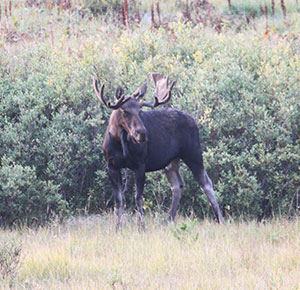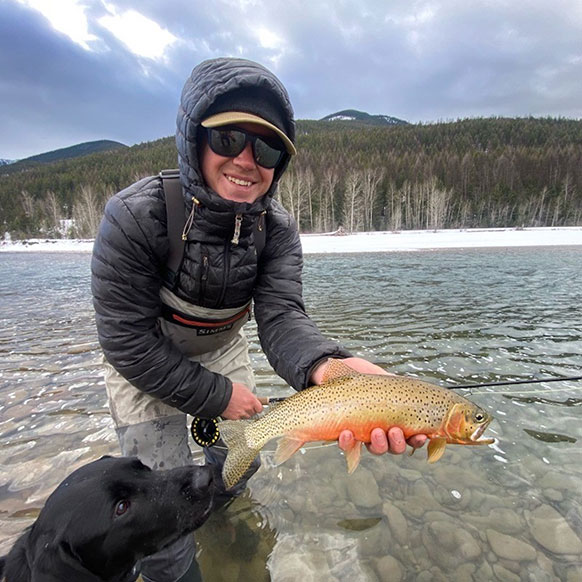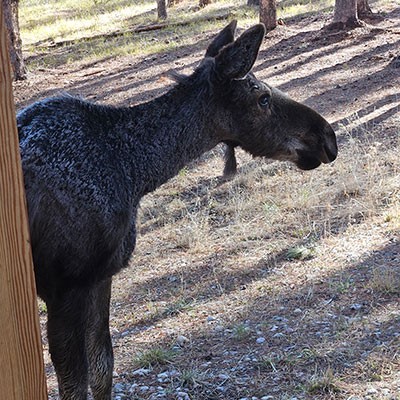UW’s Biodiversity Institute Coordinates Successful Winter Moose Day
For the eighth year running, community scientists helped track moose populations in the mountains outside of Laramie for Winter Moose Day. And they weren’t disappointed.
Fifty-five surveyors, using snowshoes or skis, trekked 25 routes in the Snowy Range and Pole Mountain areas during the Feb. 12 event, which is coordinated by the University of Wyoming’s Biodiversity Institute.
“Fifteen adult moose and four calves were seen, and many signs of moose -- scat, tracks, etc. -- were seen,” says Mason Lee, senior project coordinator of the Biodiversity Institute. “From the data I have from previous Moose Days, this is by far the most moose seen on one Winter Moose Day. The next highest was eight in 2021, when 18 routes were surveyed.”
Volunteers adopt survey routes and ski or snowshoe those routes to record all observations of moose or signs of moose. These can include tracks/hoofprints in snow, bed areas, scat droppings and browse on aspen and willows. These volunteer observations can be loaded into iNaturalist so the public can view right away where moose were seen. INaturalist is a joint initiative of the California Academy of Sciences and the National Geographic Society.
Postings from the current season can be found at www.inaturalist.org/projects/winter-moose-day.
The data gathered from Winter Moose Day are shared with biologists at UW. These biologists use the data collected by community scientists to further their understanding of the population densities of local moose, their reproductive rates, summer habitat quality, their winter ranges and how these variables change over time.
The Wyoming Game and Fish Department (WGFD) estimates there are 3,105 moose in Wyoming. The estimate is based on flight surveys conducted annually, says Sara DiRienzo, public information officer for the WGFD office in Cheyenne.
“Populations of moose in Wyoming are stabilizing,” she says, adding that 310 moose were harvested in 2020.
Lee agrees.
“It appears that populations are stable in the Snowy Range and Pole Mountain areas,” she says. “Observations of moose or moose sign on any given Moose Day can vary widely.”
For example, 16 moose were spotted during the 2016 Summer Moose Day, while only one was seen in the 2017 summer version.
“The number of surveyors per route, as well as weather conditions, can affect how many moose or even moose sign are visible,” Lee says. “For example, during the winter, strong winds often blow snow and cover any tracks that may have been visible.”
More will be learned after Dave Christianson, an associate professor in the UW Department of Ecosystem Science and Management, and his graduate students analyze the Moose Day data as well as external factors that can affect moose counts, Lee says.
Both the winter and summer Moose Day events are geared toward increasing the public’s understanding of moose in the Laramie area and involving the public in asking and answering questions. These events are an extension of the original program, Moose Day, held by Nature Mapping Jackson Hole (NMJH) in Jackson each winter. NMJH is a citizen science program created by the Jackson Hole Wildlife Foundation.
The UW Biodiversity Institute fosters conservation of biodiversity through scientific discovery, creative dissemination, education and public engagement. In this setting, scientists, citizens, students and educators come together to share a wealth of perspectives on the study and appreciation of biodiversity -- from microbes to poetry and ecosystems to economics. Learn more at www.wyomingbiodiversity.org.
Institutional Communications
Bureau of Mines Building, Room 137
Laramie
Laramie, WY 82071
Phone: (307) 766-2929
Email: cbaldwin@uwyo.edu
Share This Post

This moose was spotted last summer in the Snowy Range. This year’s Winter Moose Day, held Feb. 12, resulted in the spotting of 15 adult moose and four calves in the Snowy Range and Pole Mountain areas. (Mason Lee Photo)
Social Media
Latest News



Archives
- All
- October 2025
- August 2025
- July 2025
- June 2025
- May 2025
- April 2025
- March 2025
- February 2025
- January 2025
- November 2024
- October 2024
- September 2024
- August 2024
- July 2024
- June 2024
- May 2024
- April 2024
- March 2024
- February 2024
- January 2024
- December 2023
- November 2023
- August 2023
- July 2023
- April 2023
- September 2022
- August 2022
- July 2022
- June 2022
- May 2022
- April 2022
- March 2022
- February 2022
- January 2022
- December 2021
- November 2021
- October 2021
- September 2021
- August 2021
- May 2021
- April 2021
- March 2021
- October 2020
- August 2020
- July 2020
- January 2020
- March 2019

